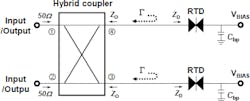As the world becomes increasingly connected, devices with extremely low power and adequate RF performance will be in demand. One of the biggest challenges that will be faced by those devices is the need to maintain low power while operating the necessary low-noise amplifiers (LNAs) for signal reception. Using resonant tunneling diodes (RTDs), a negative-differential-conductance (NDC) amplifier has been designed by Jongqon Lee, Jooseok Lee, Maengkyu Kim, and Kyounghoon Yang from the Department of Electrical Engineering of KAIST in the Republic of Korea. Their amplifier exhibits a low noise floor at very low direct-current (DC) power-consumption figures.
Indium-phosphide (InP) RTDs possess good NDC characteristics at low DC power. This feature makes them suitable for microwave wireless transmission for remote and sensor applications, which require high performance in power-restricted applications. The research team uses two RTD amplifiers joined with a hybrid coupler. The bypass capacitors, thin-film resistors, spiral inductors, and RTDs in the device are all integrated with a 0.9- μm InP monolithic-microwave-integrated-circuit (MMIC) process.
The center frequency for the low-power LNA is centered at 5.5 GHz with gain of 8.1 dB, a noise figure of 4.5 dB, and a gain-to-DC power ratio of 52.2 dB/mW. These performance metrics exceed comparable LNAs. The next-closest 180-nm CMOS process reportedly reaches just a 12.8 dB/mW gain-to-DC power ratio. See “Negative-differential-conductance RTD amplifier MMIC with record forms of gain-to-dc power ratio and noise figure,” 26th Conference on Indium Phosphide and Related Materials (IPRM), May 2014, pg. 1.

